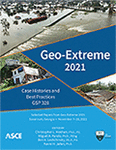Case Study of Slope Failures in Canal
Publication: Geo-Extreme 2021
ABSTRACT
An irrigation project included a well-distributed network of canals. The trapezoidal section of the main canal made a deep cut through lateritic soil and faced several major and minor slope failures during its construction. The failures, in general, were of two types: (1) retaining wall failure, and (2) surficial slope failure. The laboratory and mineralogical studies identified the dispersive nature of the lateritic soil as the primary cause of the slope failures. The results of stability analysis performed in GEO5 showed that internal and surficial erosion occurring in dispersive lateritic soil aggravated the slope failures. The high-pore pressure development during heavy rainfalls and excessive erosion of the soil from the canal slope pushed the retaining wall into the canal, thereby hindering the irrigation project. The soft and nearly saturated clayey foundation soil at these locations contributed to this sliding failure due to the loss of friction between the soil beneath and the retaining wall.
Get full access to this article
View all available purchase options and get full access to this chapter.
REFERENCES
Albrecht, B. A., and C. H. Benson. “Effect of desiccation on compacted natural clays.” Journal of Geotechnical and Geoenvironmental Engineering 127.1 (2001): 67–75.
Au, S. W. C. “Rain-induced slope instability in Hong Kong.” Engineering Geology 51.1 (1998): 1–36.
Aydin, A., and I. Egeli. “Stability of slopes cut in metasedimentary saprolites in Hong Kong.” Bulletin of Engineering Geology and the Environment 60.4 (2001): 315–319.
de Brito Galvao, T. C., and D. G. Schulze. “Mineralogical properties of a collapsible lateritic soil from Minas Gerais, Brazil.” Soil Science Society of America Journal 60.6 (1996): 1969–1978.
Gaaver, K. E. “Geotechnical properties of Egyptian collapsible soils.” Alexandria Engineering Journal 51.3 (2012): 205–210.
Helgren, D. M., and K. W. Butzer. “Paleosols of the southern Cape Coast, South Africa: implications for laterite definition, genesis, and age.” Geographical review (1977): 430–445.
Jeanroy, E., et al. “Differential dissolution of hematite and goethite in dithionite and its implication on soil yellowing.” Geoderma 50.1-2 (1991): 79–94.
Kheoruenromne, I. “Red and yellow soils and laterite formation in the Northeast Plateau, Thailand.” Chemical geology 60.1-4 (1987): 319–326.
Moffat, R., R. J. Fannin, and S. J. Garner. “Spatial and temporal progression of internal erosion in cohesionless soil.” Canadian Geotechnical Journal 48.3 (2011): 399–412.
Peterschmitt, E., et al. “Yellowing, bleaching and ferritisation processes in soil mantle of the Western Ghâts, South India.” Geoderma 74.3-4 (1996): 235–253.
Phanikumar, B. R., R. Raghav, and K. Bhargav. “Collapse behaviour of a lateritic soil.” Geomechanics and Geoengineering 11.2 (2016): 119–124.
Pitts, J. “The form and causes of slope failures in an area of West Singapore Island.” Singapore Journal of Tropical Geography 4.2 (1983): 162–168.
Rahardjo, H., Li, X. W., Toll, D. G., and Leong, E. C. (2001). The effect of antecedent rainfall on slope stability. In Unsaturated Soil Concepts and their Application in Geotechnical Practice (pp. 371–399). Springer Netherlands.
Sakuma, H. “Adhesion energy between mica surfaces: Implications for the frictional coefficient under dry and wet conditions.” Journal of Geophysical Research: Solid Earth 118.12 (2013): 6066–6075.
Information & Authors
Information
Published In
Copyright
© 2021 American Society of Civil Engineers.
History
Published online: Nov 4, 2021
Authors
Metrics & Citations
Metrics
Citations
Download citation
If you have the appropriate software installed, you can download article citation data to the citation manager of your choice. Simply select your manager software from the list below and click Download.
